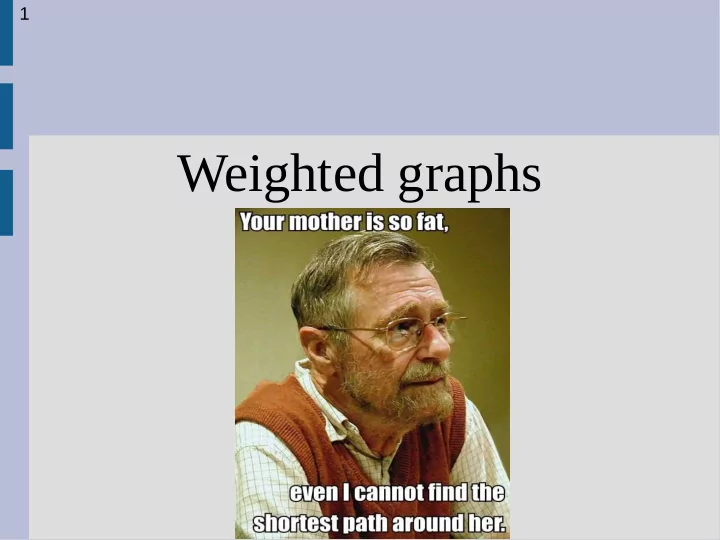

1 Weighted graphs
3 Weighted graph Edges in weighted graph are assigned a weight: w(v 1 , v 2 ), where v 1 , v 2 in V If path p = <v 0 , v 1 , ... v k > then the weight is: w(p) = ∑ k i=1 (v i-1 ,v i ) Shortest Path: δ(u,v): min{w(p) : v 0 =u,v k =v)}
4 Shortest paths Today we will look at single-source shorted paths This finds the shortest path from some starting vertex, s, to any other vertex on the graph (if it exists) This creates G π , the shortest path tree
5 Shortest paths Optimal substructure: Let δ(v 0 ,v k )=p, then for all 0 < i < j < k, δ(v i ,v j )=p i,j = <v i , v i+1 , ... v j > Proof? Where have we seen this before?
6 Shortest paths Optimal substructure: Let δ(v 0 ,v k )=p, then for all 0 < i < j < k, δ(v i ,v j )=p i,j = <v i , v i+1 , ... v j > Proof? Contradiction! Suppose w(p' i,j ) < p i,j , then let p' 0,k = p 0,i p' i,j p j,k then w(p' 0,k ) < w(p)
7 Shortest path We will do the same thing we have done before with BFS and DFS: Makes a queue and put in/pull out Two major differences: (1) How to remove from queue (min) (2) Update “grey” vertexes (“relax”)
8 Relaxation We will only do relaxation on the values v.d (min weight) for vertex v (i.e. min() function) Relax(u,v,w) if(v.d > u.d + w(u,v)) v.d = u.d+w(u,v) v.π=u
9 Relaxation We will assume all vertices start with v.d=∞,v.π=NIL except s, s.d=0 This will take O(|V|) time This will not effect the asymptotic runtime as it will be at least O(|V|) to find single-source shortest path
10 Relaxation Relaxation properties: 1. δ(s,v) < δ(s,u) + δ(u,v) (triangle inequality) 2. v.d > δ(s,v), v.d is monotonically decreasing 3. if no path, v.d =δ(s,v) =∞ 4. if δ(s,v), when (v.π).d=δ(s,v.π) then relax(v.π,v,w) causes v.d=δ(s,v) 5. if δ(v 0 ,v k ) = p 0,k , then when relaxed in order (v 0 , v 1 ), (v 1 , v 2 ), ... (v k-1 ,v k ) then v k .d=δ(v 0 ,v k ) even if other relax happen 6. when v.d=δ(s,v) for all v in V, G π is shortest path tree rooted at s
11 Directed Acyclic Graphs DFS can do topological sort (DAG) Run DFS, sort in decreasing finish time
12 Directed Acyclic Graphs DAG-shortest-paths(G,w,s) topologically sort G initialize graph from s for each u in V in topological order for each v in G.Adj[u] Relax(u,v,w) Runtime: O(|V| + |E|)
13 Depth first search
14 Directed Acyclic Graphs Correctness: Prove it!
15 Directed Acyclic Graphs Correctness: By definition of topological order, When relaxing vertex v, we have already relaxed any preceding vertices So by relaxation property 5, we have found the shortest path to all v
16 BFS (unweighted graphs) Create FIFO queue to explore unvisited nodes
17 Dijkstra Dijkstra's algorithm is the BFS equivalent for non-negative weight graphs
18 Dijkstra Dijkstra(G,w,s) initialize G from s Q = G.V, S = empty while Q not empty u = Extract-min(Q) S optional S = S U {u} for each v int G.Adj[u] relax(u,v,w)
19 Dijkstra
20 Dijkstra Runtime?
21 Dijkstra Runtime: Extract-min() run |V| times Relax runs Decrease-key() |E| times Both take O(lg n) time So O( (|V| + |E|) lg |V|) time (can get to O(|V|lg|V| + E) using Fibonacci heaps)
22 Dijkstra Runtime note: If G is almost fully connected, |E| ≈ |V| 2 Use a simple array to store v.d Extract-min() = O(|V|) Decrease-key() = O(1) total: O(|V| 2 + E)
23 Dijkstra Correctness: (p.660) Sufficient to prove when u added to S, u.d = δ(s,u) Base: s added to S first, s.d=0=δ(s,s) Termination: Loop ends after Q is empty, so V=S and we done
24 Dijkstra Step: Assume v in S has v.d = δ(s,v) Let y be the first vertex outside S on path of δ(s,u) We know by relaxation property 4, that δ(s,y)=y.d (optimal sub-structure) y.d = δ(s,y) < δ(s,u) = u.d, as w(p)>0
25 Dijkstra Step: Assume v in S has v.d = δ(s,v) But as u was picked before y, u.d < y.d, combined with y.d < u.d y.d=u.d Thus y.d = δ(s,y) = δ(s,u) = u.d
Recommend
More recommend